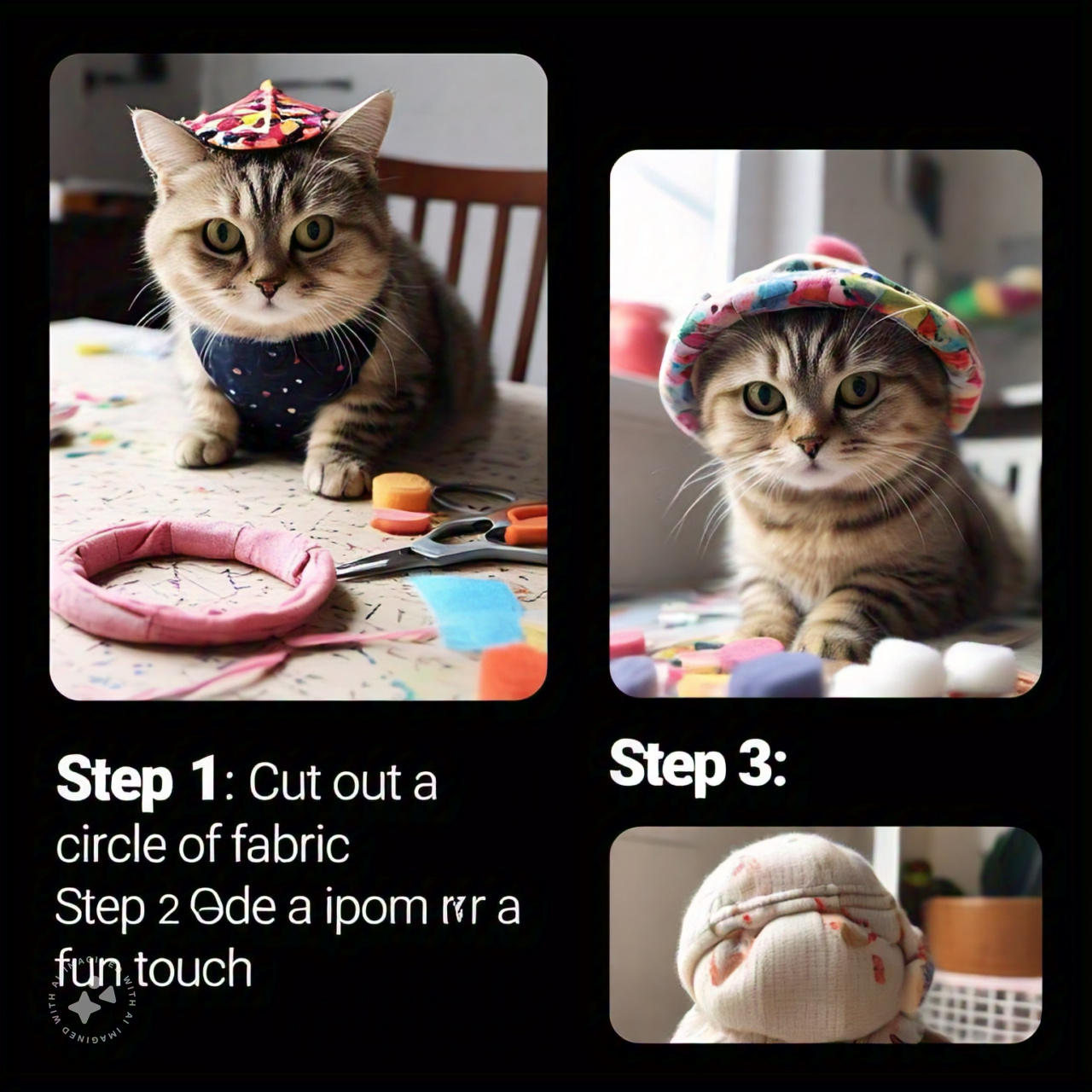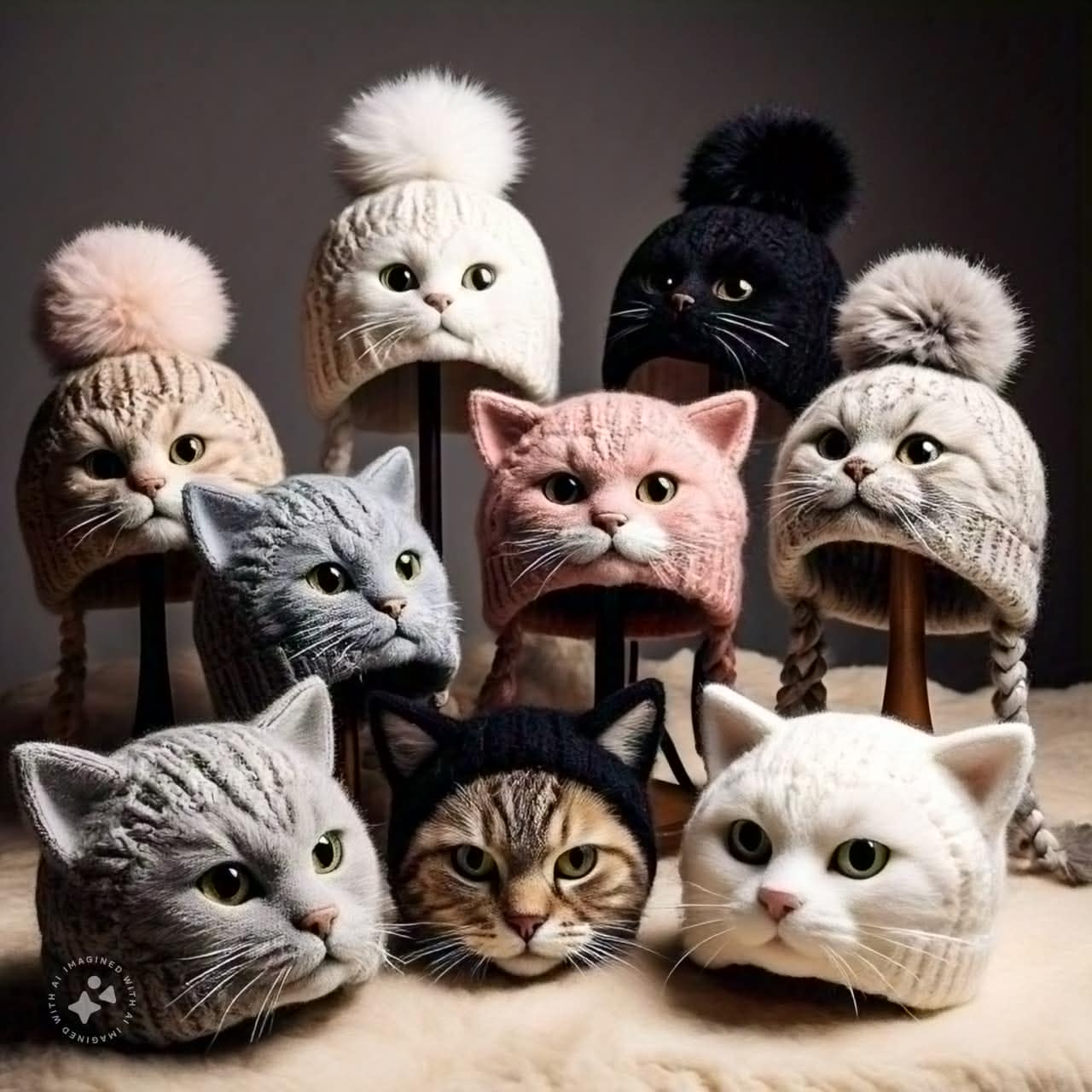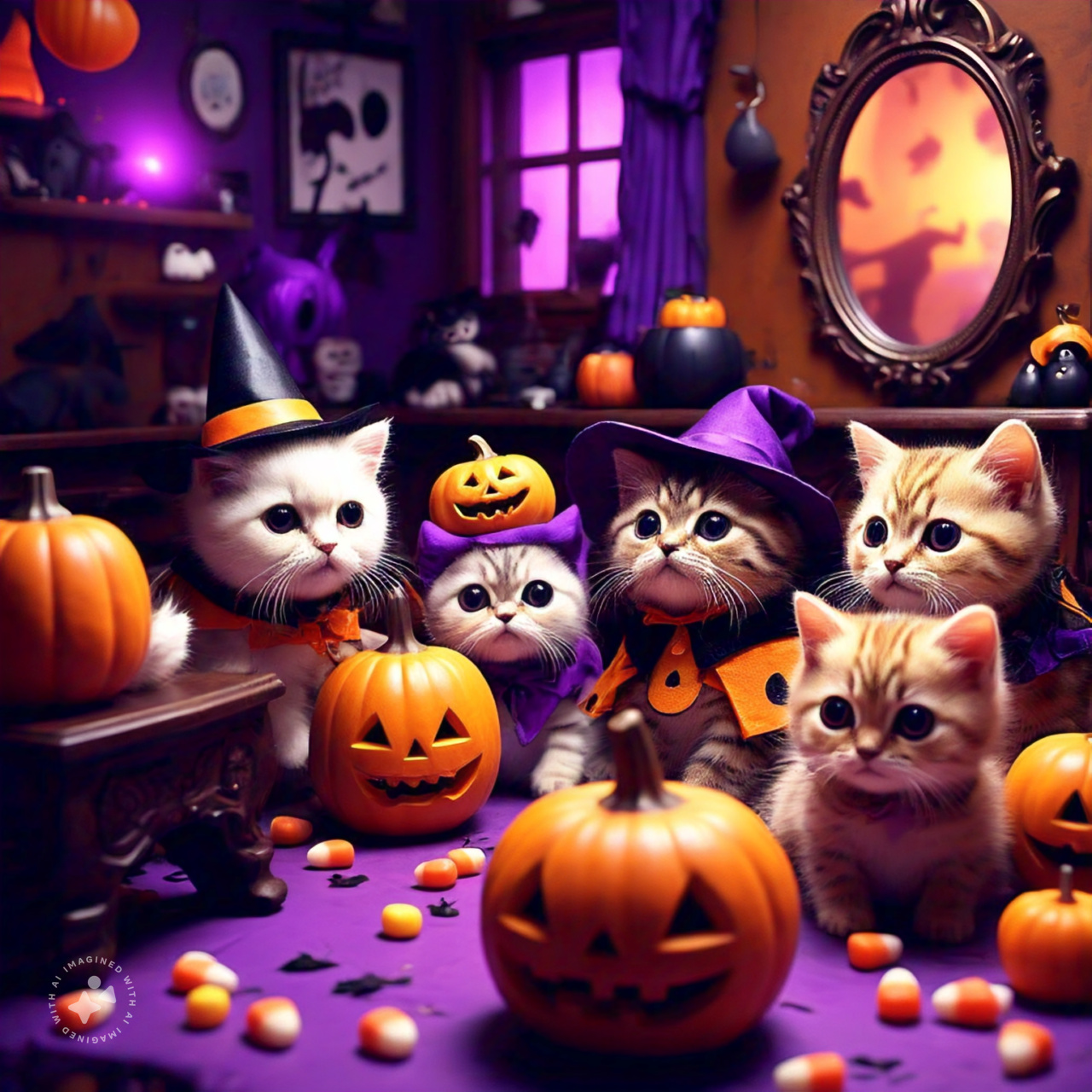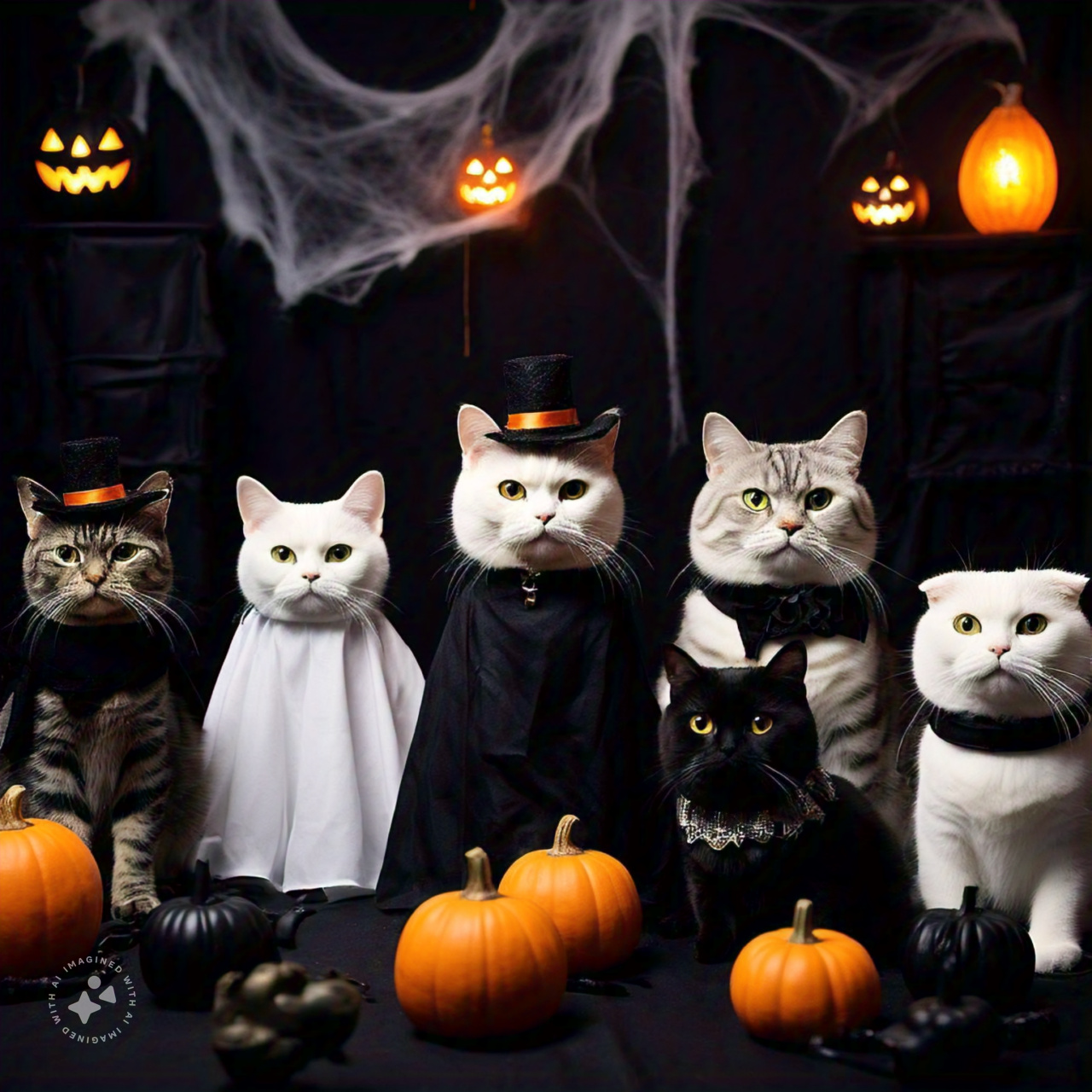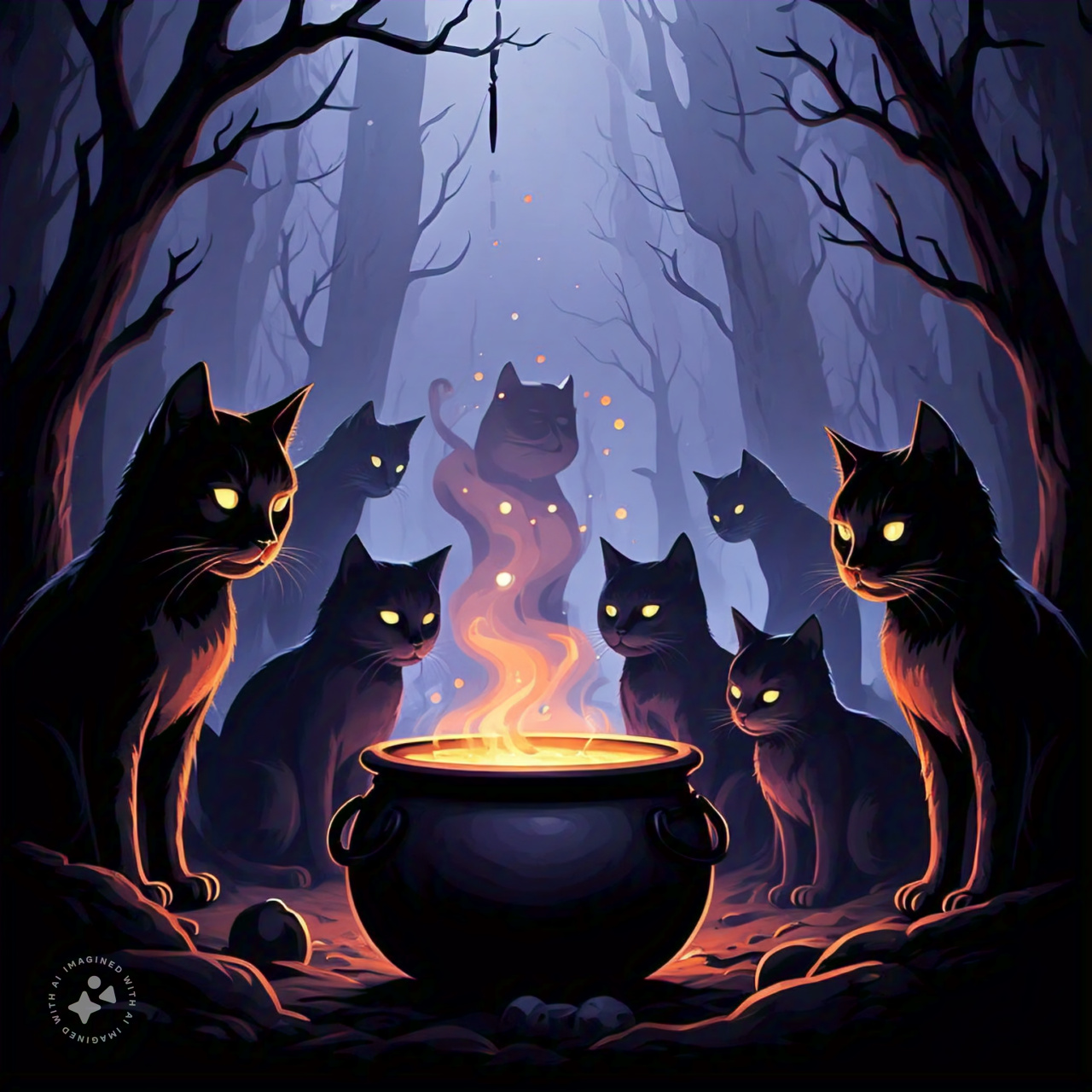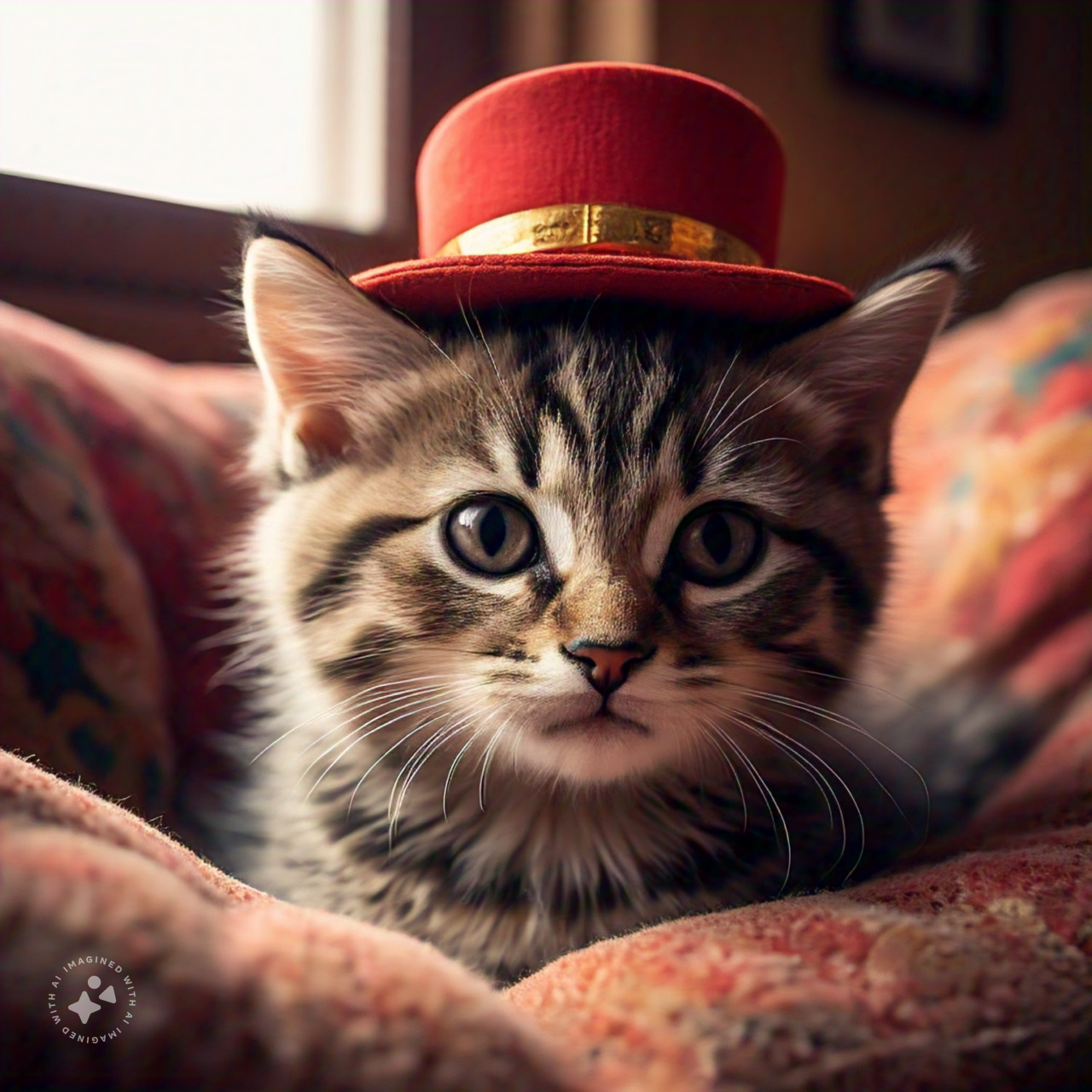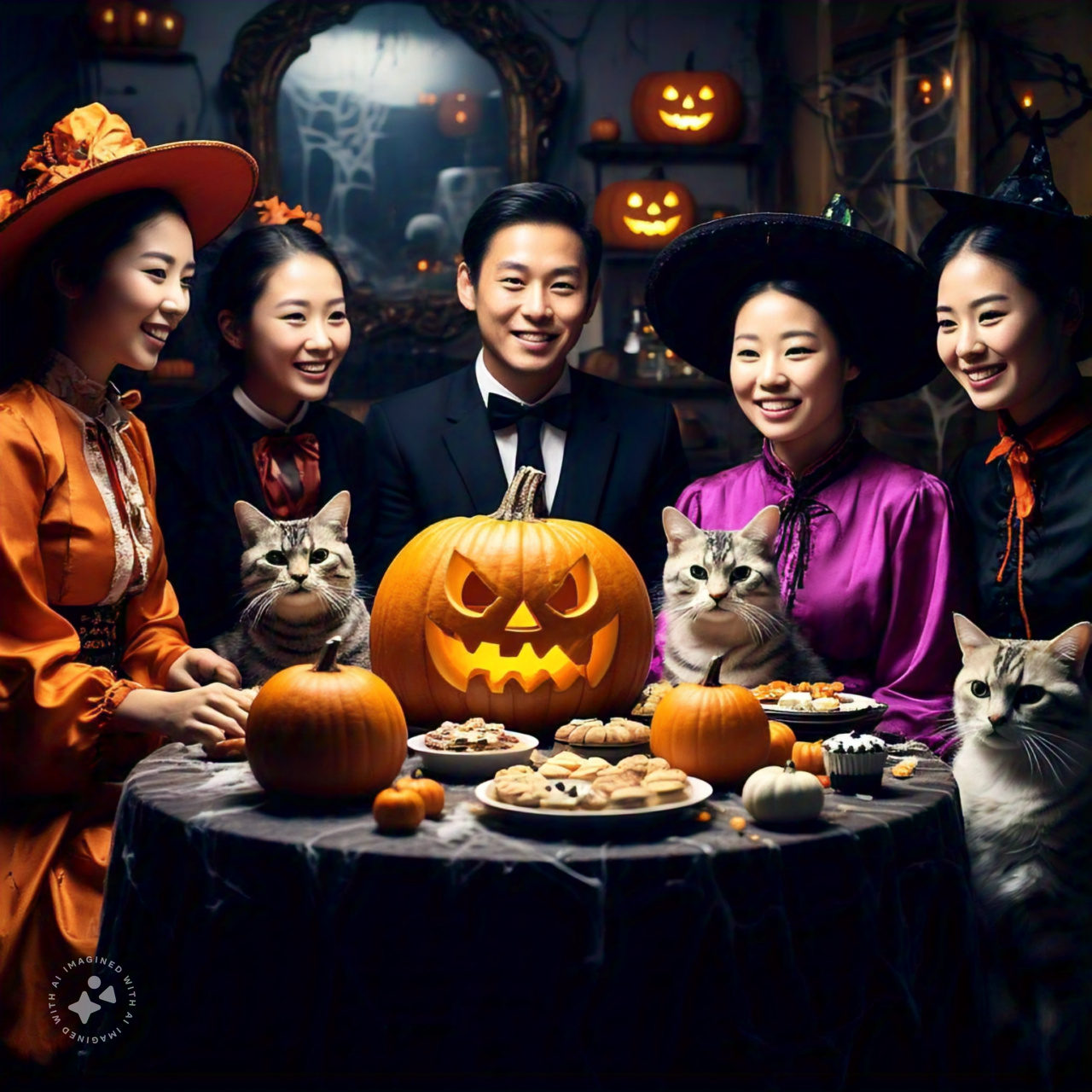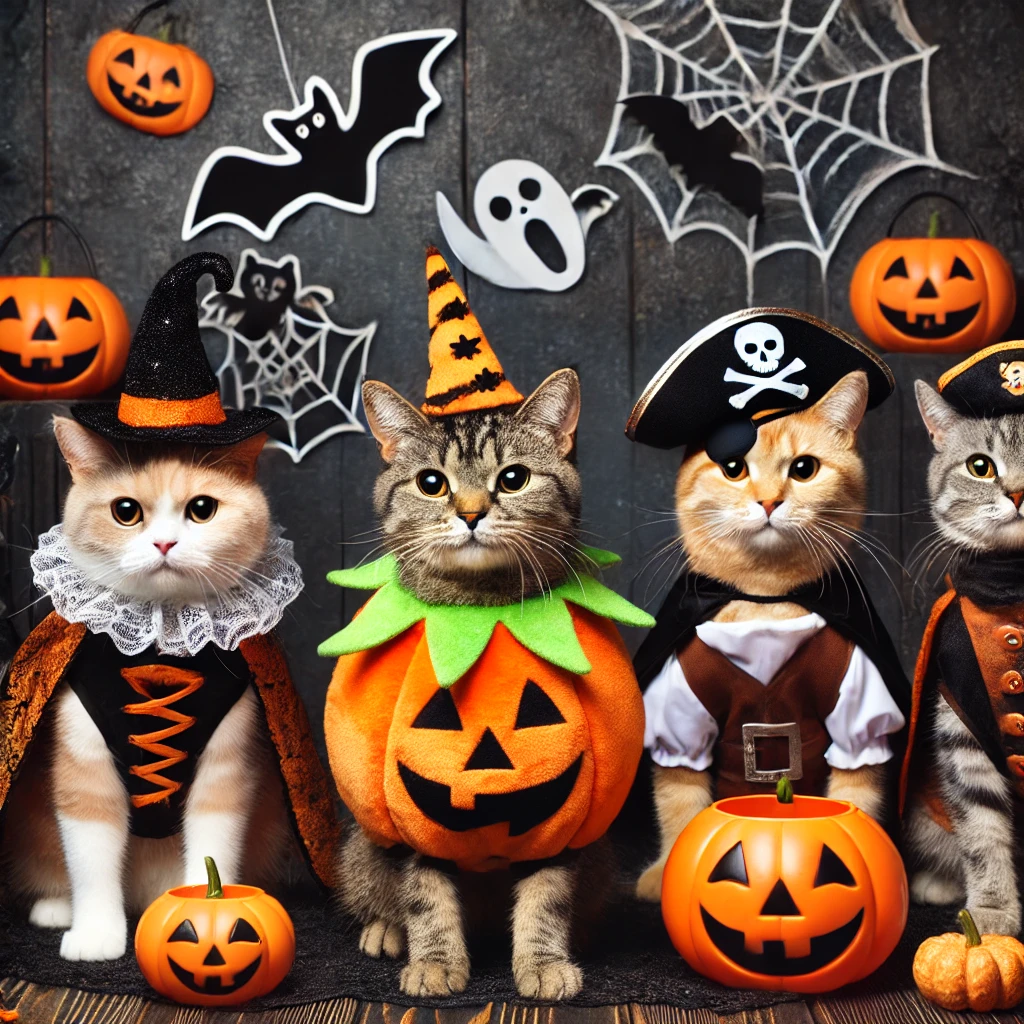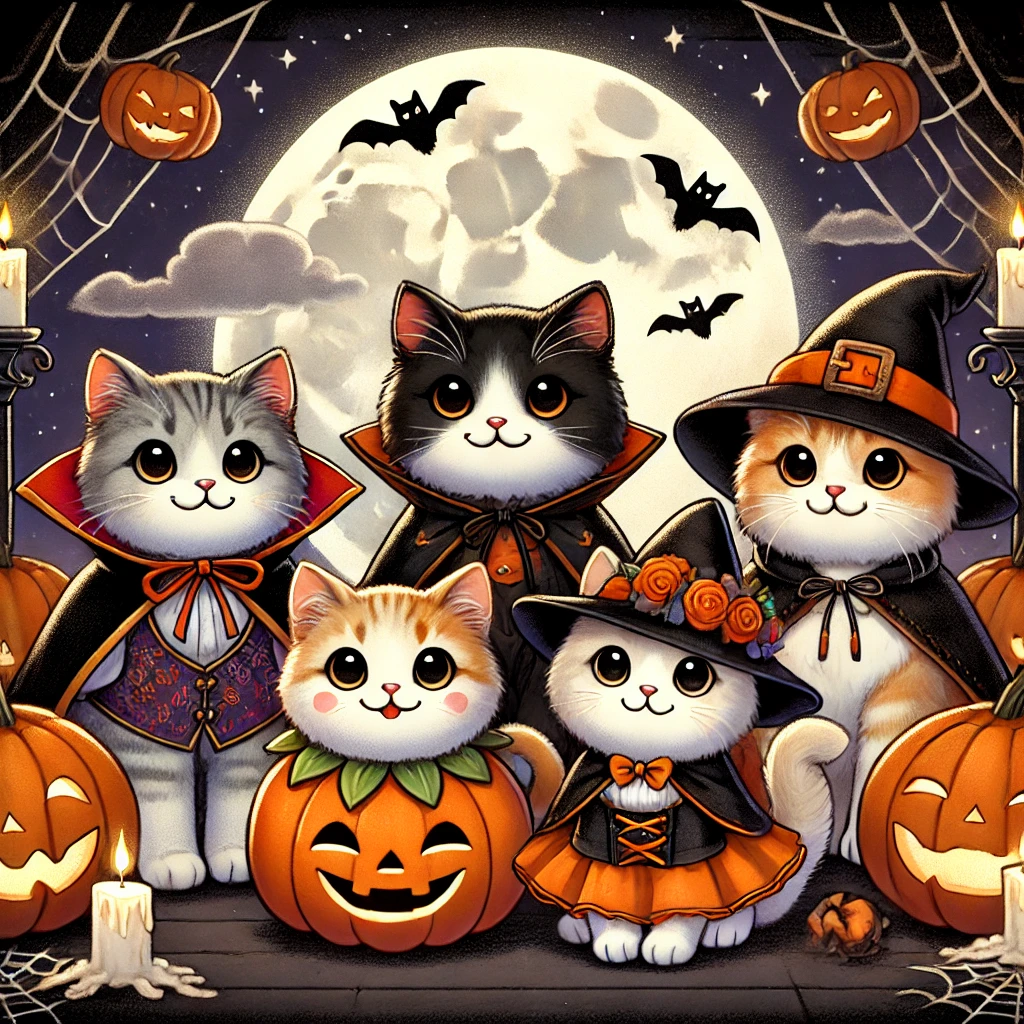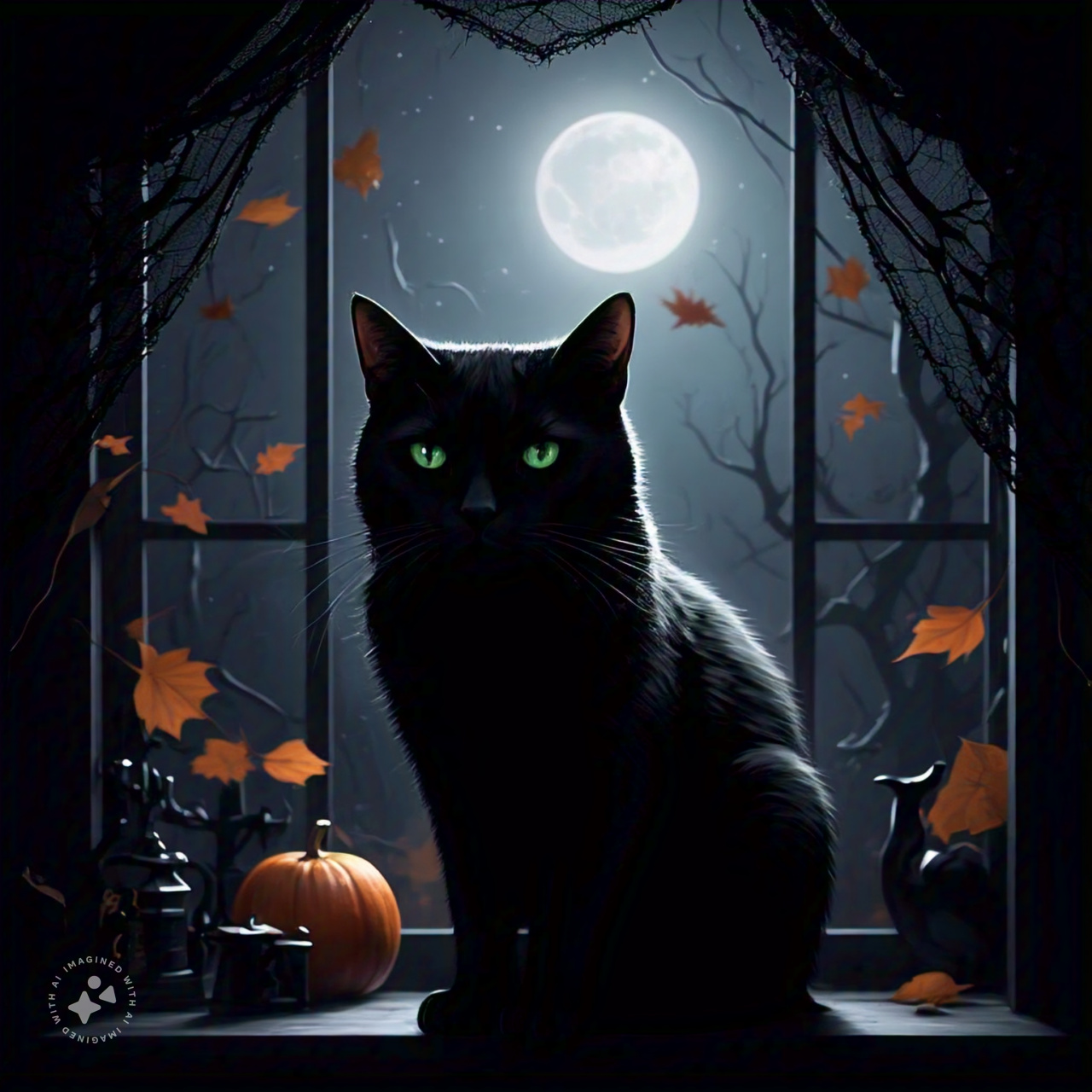The Mystical Connection Between Cats and Halloween
Halloween, with its vibrant costumes, trick-or-treating, and eerie atmosphere, holds a unique place in many cultures around the world. For centuries, it has been intertwined with a sense of mystery, magic, and the supernatural. One of the most iconic symbols of Halloween is the black cat, a creature often associated with witches, spirits, and the unknown. But how did this connection come to be? What role do cats play in the modern celebration of Halloween, and why do they continue to captivate our imaginations during this time of year?
Cats and Ancient Superstitions
The association between cats, particularly black ones, and Halloween can be traced back to ancient superstitions. Throughout history, cats were often viewed with suspicion and reverence. In ancient Egypt, cats were worshipped as symbols of grace and protection. The goddess Bastet, often depicted as a woman with the head of a lioness or a domestic cat, was revered as the protector of the home and the keeper of family hearths. Bastet’s role in Egyptian mythology highlighted the connection between cats and the supernatural. Cats were believed to possess a mysterious and mystical quality that set them apart from other animals.
As centuries passed, this reverence shifted in some parts of the world. During the Middle Ages, in Europe, black cats began to be associated with witchcraft and dark magic. The common belief was that witches could transform into cats to carry out their malevolent deeds under the cover of darkness. In some cultures, people believed that black cats could bring bad luck or were evil omens, especially around the time of harvest festivals like Halloween. This fear was particularly prominent in England, where it was believed that if a black cat crossed your path, it would bring misfortune.
Interestingly, the role of cats in Halloween folklore isn’t entirely negative. In some European countries, particularly in Scotland and Ireland, black cats were believed to bring good fortune if they entered one’s home. This paradoxical nature of the black cat—both feared and revered—only adds to its mystique, making it a fitting symbol for Halloween, a time when the veil between the living and the dead is thought to be thinnest.
Cats as Symbols of Mystery and Magic
The role of cats in Halloween traditions also ties into their broader association with the supernatural and the mysterious. Cats, with their nocturnal habits and ability to move stealthily, have long been linked to the unseen world. Their eyes, which can glow eerily in the dark, have further fueled the myth that they possess special powers, able to peer into the spirit world or see things that humans cannot.
In various cultures, cats were believed to be familiar spirits of witches. A familiar, in folklore, is an animal that assists a witch in their magical practices. Often, these animals were said to possess powers that allowed them to communicate with the dead, see future events, or ward off evil spirits. The connection between witches and their feline familiars is one of the key elements that has solidified the cat’s place in Halloween traditions, particularly in Western countries. The image of a black cat perched on the broomstick of a witch or walking alongside her on All Hallows’ Eve is a lasting representation of this supernatural relationship.
Even in modern times, cats continue to be closely tied to Halloween, appearing in decorations, costumes, and imagery associated with the holiday. Whether it’s a black cat sitting ominously in a window or a cartoon cat with a witches’ hat, these creatures are often seen as symbols of Halloween’s magical, spooky, and mysterious allure.
The Black Cat as a Symbol of Protection and Good Luck
While many Halloween traditions focus on the spooky side of cats, it’s important to recognize the positive associations these animals hold in certain cultures. In some countries, cats, especially black ones, are seen as protectors, bringing good fortune and warding off evil spirits. This belief contrasts sharply with the darker, more sinister perceptions that many people have of cats during Halloween.
In Japan, for example, cats are considered good luck, especially black ones. The Maneki-neko, or “beckoning cat,” is a common Japanese symbol believed to bring good fortune to its owner. This figurine, often seen in shops and restaurants, depicts a cat with one paw raised in a welcoming gesture. The Maneki-neko is a symbol of prosperity and protection, and the black version is thought to ward off evil spirits and bad luck. While not directly tied to Halloween, the symbolism of black cats in Japanese culture illustrates how cats have been viewed as benevolent and protective figures in various parts of the world.
Similarly, in some parts of Europe, black cats are believed to bring luck to their owners. In Ireland and Scotland, for example, it is said that a black cat crossing one’s path will bring good fortune if it happens to be from the right side. This belief reflects a more positive view of cats, suggesting that their presence is not inherently ominous but rather a harbinger of good things to come. As Halloween approaches, it is interesting to see how these contrasting perceptions—of cats as both protectors and omens of doom—continue to shape the way people celebrate the holiday.
Cats in Halloween Festivities Around the World
In many countries, Halloween traditions are influenced by local customs, folklore, and beliefs. While black cats are often linked with witches and spooky imagery in Western Halloween celebrations, other cultures have their own unique ways of incorporating cats into their festivities.
In Mexico, for instance, Halloween celebrations often overlap with the Day of the Dead, a holiday that honors deceased loved ones. While the focus of the Day of the Dead is on remembrance and celebrating the lives of the departed, cats have a place in this tradition as well. In Mexican folklore, cats are believed to have the ability to guide the spirits of the dead back to the afterlife. This connection between cats and the spirit world resonates with the themes of Halloween, a time when people honor the dead and reflect on the mysteries of the afterlife.
Similarly, in parts of Italy, Halloween is not as widely celebrated as in the United States or the United Kingdom. However, the tradition of All Saints’ Day and All Souls’ Day on November 1st and 2nd still plays an important role. During this time, cats, particularly black ones, are seen as protectors of the home, keeping unwanted spirits at bay. In these countries, Halloween may not be as commercialized as it is elsewhere, but the mystical presence of cats during this time still holds meaning for many.
In conclusion, the mystical connection between cats and Halloween is deeply rooted in history, folklore, and cultural traditions. Cats have long been associated with magic, mystery, and the supernatural, making them an integral part of Halloween celebrations around the world. Whether they are seen as protectors or omens, cats continue to captivate the imagination and remain one of the most enduring symbols of the holiday. Their presence adds to the eerie and magical atmosphere of Halloween, making them a beloved part of the celebration for people of all ages.
The Role of Cats in Halloween Celebrations Across Cultures
Halloween, with its widespread recognition, has evolved into a globally celebrated holiday, yet the traditions associated with it vary from country to country. Cats, particularly black ones, feature prominently in many Halloween customs, but their roles and the way they are celebrated can differ based on cultural contexts. From the United States to Japan and beyond, the significance of cats during this eerie holiday takes on unique meanings, both as symbols of good fortune and bad omens. Understanding how different cultures incorporate cats into their Halloween traditions provides insight into how universal yet culturally specific the connection between cats and Halloween truly is.
Cats in American Halloween Traditions
In the United States, Halloween is one of the most widely celebrated holidays, with people of all ages participating in a range of spooky activities, from trick-or-treating to elaborate costume parties. Cats, especially black ones, have become quintessential symbols of the Halloween season, appearing in decorations, costumes, and even as part of haunted house attractions. These feline figures often represent the mysterious and the supernatural, fitting seamlessly into the broader Halloween theme of things that go bump in the night.
In American folklore, black cats are often linked with witchcraft, as witches were believed to have a deep connection with these animals, often said to be their familiars. The image of a black cat sitting at the feet of a witch or walking along a dark, misty road has been a staple of Halloween imagery. This connection to witches is part of the reason that cats, particularly black ones, are seen as creatures of the night, evoking thoughts of spells, potions, and otherworldly forces. It is not uncommon to see black cat motifs on Halloween decorations, from the playful to the eerie, and their symbolism continues to grow during the spooky season.
Beyond the symbolic and folkloric significance of cats in Halloween, they are also widely celebrated in American culture through costumes and media. Children and adults alike dress up as witches, with black cats often accompanying them in costume form. These feline-inspired costumes, whether as part of a witch’s ensemble or on their own, continue to be a popular choice during Halloween festivities, highlighting the ongoing fascination with these creatures. Black cats, often dressed in elaborate garb with eerie eyes and sleek fur, evoke a sense of both mystery and playful spookiness that embodies the spirit of the season.
Moreover, Halloween-themed events in the U.S., such as haunted houses and pumpkin carving festivals, also feature black cat imagery. Many Halloween-themed events include representations of cats as ominous figures, such as black cat figurines that sit atop pumpkins or prowling around spooky displays. The connection between cats and Halloween in American culture, while rooted in ancient superstitions, continues to grow stronger, as these animals have become intertwined with the modern commercialized celebration of the holiday.
Cats in European Halloween Traditions
While Halloween traditions in the United States often borrow from earlier European customs, the role of cats in Europe’s Halloween celebrations can be quite varied, reflecting diverse cultural attitudes toward cats, death, and the supernatural. In countries such as the United Kingdom, Ireland, and France, cats have a strong symbolic presence during Halloween, but their meanings may differ depending on local folklore and customs.
In the United Kingdom, black cats are often seen as symbols of bad luck, particularly if they cross one’s path. This superstition, which may seem ominous to those unfamiliar with British folklore, is still prevalent during Halloween. The belief in black cats as harbingers of misfortune is one of the most enduring superstitions in the country. However, the role of the cat in Halloween traditions has also evolved. In modern times, while the association of black cats with witches and magic is still strong, many people embrace them as fun, spooky symbols that add to the festive atmosphere.
In Ireland, Halloween (or Samhain, the ancient Gaelic festival that Halloween evolved from) holds a deep connection to spirits and the afterlife. Cats, particularly black ones, were once believed to be protectors of the home, warding off evil spirits that might roam the earth on Halloween night. However, this protective role is tempered by their association with witchcraft and the supernatural. It was common for people in Ireland to keep their cats indoors on Halloween to prevent them from being targeted by superstitious practices or becoming victims of the local folklore that saw them as accomplices to witches.
On the other hand, in France, Halloween celebrations are still relatively new, but black cats have a long history in French culture. Cats were revered during the medieval period, often believed to have magical abilities. As Halloween has slowly gained popularity in France, black cats have emerged as central symbols of the holiday, adorning decorations, cards, and other festive elements. In some rural regions of France, people still hold on to the ancient belief that cats, especially black ones, possess a mystical ability to connect with spirits, and on Halloween, they are seen as conduits between the living and the dead.
While black cats are often associated with witches and bad luck in European folklore, their significance in Halloween celebrations varies. In the modern-day celebration of Halloween across Europe, cats are less likely to be feared as much as they were in the past. Instead, they have become part of the playful and spooky nature of the holiday, appearing in decorations, costumes, and media as part of the festive imagery.
The Influence of Cats in Halloween Traditions in Japan
In contrast to Western traditions, Japan’s Halloween celebrations are relatively new but have grown in popularity in recent years, especially in urban areas. Japanese culture, however, has a much older connection to cats, which are often seen as mystical beings, and this connection has influenced how Halloween is celebrated in the country.
In Japanese folklore, cats, particularly black ones, are believed to have spiritual significance. They are often seen as protectors of the home, much like in Western cultures, but they also have a role in warding off evil spirits. The famous “Maneki-neko,” or beckoning cat, is a common symbol of good luck in Japan and is often found in homes and businesses. While not directly related to Halloween, the association of cats with fortune and protection fits neatly within the context of Halloween celebrations, which are closely tied to spirits and the supernatural.
One of the most fascinating aspects of cats in Japanese culture is their association with the paranormal. Cats are often believed to have the ability to see spirits or possess supernatural powers. This belief in their spiritual connection makes them an ideal fit for Halloween, a time when the boundary between the living and the dead is said to be at its thinnest. During Halloween in Japan, cats are often depicted in a playful, cute, and eerie manner, particularly in costumes and decorations, where they embody both the mystical and the playful aspects of the holiday.
In recent years, Japanese Halloween celebrations have become more commercialized, with public events and parades drawing large crowds. Here, cats play a significant role in the festivities. Black cats, in particular, are often seen in costumes and used in advertisements and media promotions leading up to Halloween. The integration of cats into these modern Halloween celebrations reflects their enduring popularity and the continued fascination with their mysterious, otherworldly nature.
Cats and Halloween: A Universal Symbol of Mystery and Magic
No matter where one celebrates Halloween, the role of cats is universal: they are symbols of mystery, magic, and the unknown. In every culture, from the United States to Japan, cats—especially black ones—serve as reminders of the supernatural forces that are said to come to life on Halloween night. Whether they are protectors of the home, familiars of witches, or spirits that guide the dead, cats have carved out an enduring place in Halloween traditions.
The fascination with cats during Halloween celebrations is a testament to the enduring allure of these creatures, whose mysterious qualities continue to inspire awe and wonder. Their role in Halloween celebrations around the world, whether they are seen as protectors or omens of doom, highlights how deeply embedded these creatures are in our cultural imagination. As Halloween continues to be celebrated across the globe, the role of cats—those creatures of the night—will likely remain a central part of the festivities, their symbolism shifting and evolving with the times, yet always maintaining their connection to the mysterious and magical.
The Evolution of Halloween with Cats in Modern Pop Culture
Halloween’s evolution from ancient traditions into a contemporary global celebration has brought about significant changes in the way the holiday is celebrated, including the role of cats. What was once rooted in superstition and folklore has now been intertwined with modern pop culture, creating a more playful, commercialized, and whimsical approach to celebrating Halloween. Cats, particularly black ones, have not only survived this transformation but have thrived, appearing in a variety of forms, from costumes to animated characters and social media content.
This part will explore how Halloween with cats has evolved in popular culture, examining the continued relevance of these mysterious creatures, their portrayal in entertainment, and how they have become symbols of fun, mischief, and enchantment for people of all ages.
Cats in Halloween Costumes and Decorations
One of the most visible ways in which cats are celebrated during Halloween today is through costumes and decorations. As Halloween has become increasingly commercialized, costumes and themed decorations have become integral to the holiday experience. Cats, especially black ones, have become a common feature in these decorations. From cat-shaped pumpkins to black cat lawn ornaments, these feline figures are now part of the visual landscape of Halloween.
The popularity of black cats in Halloween costumes is another testament to their continued relevance. For many, dressing up as a cat during Halloween is a playful and fun choice. Cat costumes can range from simple representations of a black cat with pointy ears and a tail, to elaborate outfits complete with whiskers, claws, and even cat makeup. These costumes, especially the black cat variety, embrace the spooky side of Halloween but with a humorous or cute twist. The rise of “sexy cat” costumes or even “cat witch” outfits highlights the intersection of Halloween’s darker history with modern pop culture’s focus on playful and entertaining elements.
These costumes are not limited to children, either. Adults often embrace the trend, donning their own interpretations of cat costumes. For many, wearing a cat costume is a lighthearted way to engage in the holiday spirit, and this trend has only grown in popularity over the years. Additionally, the creation of costumes for pets—especially cats—has also become a growing trend. Pet owners often dress up their cats in Halloween-themed costumes, creating an amusing spectacle that delights onlookers. In fact, one of the most viral trends in recent years has been the posting of photos and videos of cats dressed in Halloween costumes on social media platforms, adding to the fun and playful side of Halloween celebrations.
The widespread popularity of cat-themed costumes and decorations serves to normalize the spooky association between cats and Halloween while making them more approachable, humorous, and part of the mainstream celebration. This shift represents the broader movement of turning something once feared into something beloved, and black cats, in particular, have become one of the most iconic symbols of Halloween’s modern incarnation.
Cats in Media: Films, Television, and Animation
The portrayal of cats in popular media has also contributed significantly to their status as Halloween icons. Over the years, numerous films, television shows, and animated series have featured cats in a variety of roles, cementing their place as Halloween staples in pop culture. From mischievous tricksters to wise and magical creatures, cats have been depicted in a wide array of ways, each representation contributing to their mystique and fascination.
Perhaps the most iconic feline character associated with Halloween is the black cat in Disney’s animated film The Black Cat (1922). Although the film itself is not centered around Halloween, its eerie atmosphere and black cat imagery have made it a part of Halloween’s cultural fabric. Similarly, in the 1993 classic film Hocus Pocus, the character of Binx, a talking black cat, has become a fan favorite during Halloween season. In the film, Binx is a magical cat cursed to live for centuries and serves as the protector of a young girl. His role in Hocus Pocus highlights the connection between cats and magic, adding to the idea that cats are guardians of the supernatural. This movie has grown in popularity over the years, especially among Halloween enthusiasts, and has further entrenched cats in the public’s collective imagination when it comes to the spooky season.
In addition to films, cats also make regular appearances in Halloween-themed television episodes and specials. Shows like The Simpsons and Sabrina the Teenage Witch often feature black cats as part of their Halloween-themed episodes, blending the supernatural with humor. The recurring appearance of cats in such shows reinforces their association with the holiday while also reflecting the changing nature of Halloween—from something rooted in fear and superstition to a more fun and celebratory occasion.
Animated cats, in particular, have played an important role in shaping how the public perceives these animals during Halloween. Characters like Garfield, who has appeared in Halloween-themed episodes, and Felix the Cat, with his mischievous antics, have transformed cats from objects of fear into characters of comedy and charm. These portrayals further humanize the black cat, making it less of a symbol of doom and more of an entertaining and endearing creature.
Social Media and Cats: The Halloween Trend
In recent years, the rise of social media platforms like Instagram, Twitter, and TikTok has led to a resurgence in cat popularity during Halloween. Pet influencers, in particular, have embraced the Halloween season by posting adorable or spooky photos of their cats in costume. These social media trends not only add to the playful side of Halloween but also reflect the way in which modern technology has further integrated cats into popular culture.
The hashtag #BlackCatHalloween has become a popular trend where users share their cat-themed Halloween costumes or simply post photos of their black cats, dressed up in spooky outfits or sitting among pumpkins and Halloween decorations. These online communities, fueled by cat lovers and Halloween enthusiasts alike, celebrate the mysterious allure of cats in the most lighthearted way possible. For many, these shared moments bring a sense of joy and creativity to Halloween, as people from around the world exchange tips, ideas, and images of their feline friends celebrating the season.
Moreover, viral videos of cats reacting to Halloween decorations, costumes, or even the famous “Halloween cat challenge” (where a cat jumps into a pumpkin or reacts to spooky sounds) have also gained widespread attention on social media. These humorous and sometimes heartwarming moments are shared millions of times, further solidifying cats as a central element of Halloween celebrations. The digital age has allowed Halloween with cats to expand beyond local traditions, giving a global audience the chance to enjoy and participate in the fun.
Social media’s celebration of cats during Halloween has helped reshape their image. While cats may have once been associated with the supernatural and ominous omens, modern technology has softened these associations. Cats are now seen as playful, lovable creatures that can participate in the fun of Halloween, whether they’re dressed in adorable costumes or simply perched on a pumpkin, looking aloof and regal.
The Lasting Legacy of Cats in Halloween Culture
As Halloween continues to evolve in the 21st century, cats remain an integral part of the holiday’s cultural fabric. What was once a symbol of superstition and fear has now become an emblem of fun, mischief, and magic. Cats, particularly black ones, have endured centuries of shifting cultural attitudes and have emerged as one of the most beloved symbols of Halloween. From folklore to modern media, Halloween with cats reflects both the spooky and the playful sides of the holiday.
The integration of cats into Halloween traditions and pop culture has allowed these mystical creatures to maintain their relevance, making them a central part of the holiday’s celebrations across the globe. Whether in costumes, media, or social media trends, cats will continue to be celebrated as symbols of Halloween, embodying the mystery, magic, and delight that the holiday represents.
The Spiritual and Superstitious Role of Cats in Halloween Traditions
The role of cats in Halloween celebrations is not limited to decorations, costumes, or pop culture representations. Their deep connection to the supernatural and spiritual realms plays a significant role in how they are viewed during the holiday season. From ancient superstitions to modern-day practices, cats—particularly black cats—have long been linked with the spiritual world. Halloween, a time when the veil between the living and the dead is believed to be thinnest, is the perfect occasion to reflect on the mysterious, magical, and sometimes eerie qualities of cats. Their symbolic presence at Halloween transcends mere superstition and touches on the deeper, often unsettling aspects of human belief and culture.
This section will delve into the spiritual and superstitious beliefs surrounding cats during Halloween, exploring how they are regarded as creatures of the night, associated with witches, ghosts, and other supernatural phenomena. It will also examine the cultural implications of these beliefs and how they continue to shape the ways in which we perceive cats in relation to Halloween.
Cats and Their Connection to Witches and Magic
Perhaps the most enduring association between cats and Halloween stems from their deep-rooted connection to witchcraft and magic. For centuries, black cats have been linked with witches, often seen as their familiars or magical companions. This belief is most prevalent in Western folklore, where cats—especially black ones—were thought to have the ability to perform supernatural tasks, such as casting spells or communicating with spirits. In the context of Halloween, a holiday often associated with witches, the presence of cats is a natural fit.
The idea of the witch’s cat is deeply embedded in historical witchcraft beliefs. During the European witch hunts of the Middle Ages, cats—particularly black ones—were often seen as creatures that could channel the powers of witches, acting as intermediaries between the witch and the spirit world. It was believed that witches would use their cats to carry out malevolent acts, casting spells, and causing harm to their enemies. In this context, the black cat became a symbol of both fear and power, its sleek black fur and mysterious behavior reinforcing its association with dark magic.
Even today, the black cat’s connection to witches remains an integral part of Halloween lore. Halloween costumes often feature witches with black cats at their feet, while imagery of witches stirring potions or casting spells is incomplete without the presence of a feline companion. This archetype has persisted in modern Halloween celebrations, as witches and black cats remain some of the most iconic symbols of the holiday.
However, the connection between cats and witchcraft is not solely negative. In some cultures, cats are regarded as protectors, linked with the idea of safeguarding one from evil forces. For example, in ancient Egypt, the goddess Bastet, who was depicted as a lioness or a domestic cat, was revered as a protector of the home and family. In this context, cats symbolize not only mystery but also protection and guardianship. This dual nature of cats—as both potential agents of evil and guardians against it—adds layers of complexity to their role in Halloween celebrations.
The Spiritual Symbolism of Cats on Halloween
Beyond their associations with witches and magic, cats have long been seen as spiritual creatures, often believed to have the ability to sense or interact with spirits. This belief is especially prevalent during Halloween, a time when people celebrate the thin boundary between the living and the dead. Cats are thought to possess an innate ability to see things that humans cannot, making them ideal companions in the world of the supernatural.
Many cultures believe that cats have a spiritual connection to the afterlife, able to sense the presence of spirits or communicate with entities from the beyond. In ancient Egypt, for example, cats were considered sacred animals, believed to possess a divine connection to the gods. Their sharp senses were thought to allow them to detect spirits and energies that ordinary humans could not perceive. This belief continued in various forms throughout history, and cats were often seen as protectors against evil spirits or as guides for souls in the afterlife.
On Halloween night, when the barrier between the living and the dead is believed to be at its thinnest, the presence of a cat—especially a black one—is thought to amplify the connection between the physical and spiritual realms. Cats are often seen as guardians who can ward off malevolent spirits, or as intermediaries who can communicate with the departed. This connection between cats and the spiritual world adds to their allure and mystery during Halloween, as people engage with the holiday’s themes of death, resurrection, and the unknown.
In some traditions, it was believed that black cats could serve as protectors of the home on Halloween night, guarding against evil spirits or mischievous entities that roamed the earth during this time. This belief likely stemmed from the association of cats with supernatural forces, and their ability to protect or purify spaces from harmful energies. In this context, cats were not feared as omens of doom, but revered as guardians of the home and family during the Halloween season.
Superstitions Surrounding Cats on Halloween
The superstitions surrounding cats, particularly black ones, are a prominent feature of Halloween traditions. These superstitions, rooted in centuries of cultural beliefs, continue to influence how people view cats during this time of year. The most well-known superstition is the idea that a black cat crossing one’s path brings bad luck. This belief, which is widespread in many cultures, has long been associated with Halloween, reinforcing the idea that cats are creatures of mystery and danger.
In Western cultures, particularly in the United States and Europe, the belief that a black cat crossing your path is an omen of bad luck persists to this day. This superstition likely originated in the Middle Ages, when black cats were associated with witches and evil spirits. It was believed that if a black cat crossed your path, it was either a sign of witchcraft or an indication that you were about to encounter misfortune. The connection between black cats and bad luck was particularly strong during Halloween, when the lines between the living and the dead were believed to be blurred, and all things supernatural were thought to be at their most powerful.
However, in some cultures, black cats are regarded as symbols of good luck, rather than misfortune. In Japan, for example, it is believed that a black cat crossing one’s path brings good fortune, particularly in matters of love and relationships. This positive association with black cats has gained popularity in recent years, especially among those who view them as symbols of protection and prosperity. In the context of Halloween, this superstition adds another layer of complexity to the role of cats, as they are not universally seen as symbols of evil but also of good fortune.
In addition to the belief about black cats crossing paths, other superstitions abound regarding their role in Halloween. For example, some people believe that if a cat is seen sitting on a windowsill on Halloween night, it is a sign that the house is protected from evil spirits. In contrast, if a cat is seen prowling around the home, it could be an indication that the house is under threat from malevolent forces. These superstitions reflect the ongoing connection between cats and the supernatural, and how their presence during Halloween can invoke feelings of fear, protection, or even awe.
Cats and Their Connection to the Harvest and Seasonal Traditions
In addition to their supernatural associations, cats also play a role in seasonal traditions that intersect with Halloween. Cats have long been linked to the harvest season, a time when the natural world is in transition and the boundaries between life and death are particularly pronounced. In many agricultural societies, cats were considered protectors of crops, particularly grain stores, as they helped control rodent populations that could damage food supplies. This connection between cats and the harvest season adds an agricultural dimension to their role in Halloween celebrations.
During Halloween, which coincides with the harvest festival in many cultures, cats are sometimes viewed as symbols of fertility, abundance, and the cyclical nature of life and death. In Celtic traditions, which influenced modern Halloween customs, animals—including cats—were believed to have special powers during the harvest season. The autumn months were seen as a time when the earth was in its final stages of growth before the onset of winter, and cats were thought to play a role in maintaining the balance between life and death.
In this sense, cats represent the delicate balance between the living and the dead, the fertile and the barren, making them the perfect companions for Halloween celebrations, which are steeped in themes of transformation, renewal, and the seasonal cycle. Their ability to navigate both the physical and spiritual worlds has made them enduring symbols of Halloween, representing the mysteries of nature and the unknown.
Conclusion: Cats, Magic, and the Everlasting Appeal of Halloween
As we have seen, the role of cats—especially black cats—during Halloween is rich in historical, spiritual, and cultural significance. Whether as symbols of magic, guardians of the supernatural, or playful companions during the holiday season, cats have become an essential part of Halloween celebrations across the globe. Their connection to witches, ghosts, and the supernatural world has given them a place in the holiday’s lore, while their more modern representation as fun, cute, and mischievous creatures has ensured their continued relevance in contemporary Halloween culture.
From ancient superstitions to modern-day media portrayals, the mystique of cats has endured through the centuries. Halloween, with its themes of transformation, magic, and mystery, remains the perfect occasion to celebrate these enigmatic creatures. As long as the holiday continues to captivate our imaginations, cats will undoubtedly remain central figures in the celebration of Halloween, bridging the gap between the physical world and the supernatural, and reminding us of the magic and mystery that the season brings.
